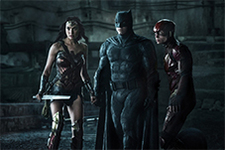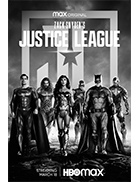Zack Snyder's Justice League
|  When Justice League was released in theaters in November 2017, it was credited as having been directed by Zack Snyder, who DC Comics had entrusted with the cinematic rendering of their vast superhero universe beginning with Man of Steel (2013) and continuing with Batman v Superman: Dawn of Justice (2016). However, as we now know, little of that version of Justice League was actually Snyder’s because he stepped down in the middle of production to cope with his daughter’s suicide. The production was taken over by Joss Whedon, who had helmed Marvel’s The Avengers (2015) and Avengers: Age of Ultron (2017). The assumption by many at the time (myself included) was that Whedon had only moderate impact on the finished film and that the majority of it was still Snyder’s. However, it soon became apparent that Whedon had substantially changed what Snyder had started, cutting huge swaths of footage and reshooting much of the film, to the point that, according to actor Ray Fisher and cinematographer Fabian Wagner, Justice League contained less than an hour of what Snyder had shot. There had long been grumbling among Snyder’s fans about Whedon’s involvement in the film, and once it became clear that he had taken over and largely altered it, rather than simply completing what Snyder had started, that grumbling turned to clamoring for the fabled “Snyder Cut,” the version of the film that Snyder intended. An online campaign was launched, but it felt like a pipe dream—a delusional fanboy fantasy of redemption and resurrection (an apt concept given the importance in the film of Superman’s being raised from the dead)`. The title Justice League took on new meaning for Snyder’s fans, as their beloved directed deserved his own justice: being able to finish his film. There were rumors of an already existing Snyder Cut, and there were rumors of hours of footage that Whedon had discarded that were just waiting to be assembled. But it always seemed unlikely that anything would come of it, and the Snyder Cut would take its place in the pantheon of ill-fated, unfinished, and never realized projects, from Sergei Eisenstein’s Ivan the Terrible Part III, to Alejandro Jodorowsky’s Dune, to Tim Burton’s Superman Lives. And yet, something did come of it, as Warner Bros. not only allowed Snyder to return to the project and complete it as he originally intended, but funded it to the tune of $70 million with new special effects and reshoots, including a tacked-on epilogue that serves primarily to suggest where Snyder would have taken the franchise if given the opportunity. Such a move is virtually unheard of in the storied annals of Hollywood history; while many directors have returned to completed films and altered them in some way to produce another version (hell, Steven Spielberg has given us three versions of Close Encounters of the Third Kind and Francis Ford Coppola has given us four cuts of Apocalypse Now), I cannot think of another instance in which a director left a project, had it completed by another filmmaker, and then returned to essentially remake it all over again. But, that is exactly what has happened here. Clocking in at more than four hours and divided into six chapters (a luxury afforded by its being released on HBO Max instead of theaters), the aptly titled Zack Snyder’s Justice League is an indulgent deep, dark dive into superhero mythos, and Snyder leaves no stone unturned. Everything that felt clipped or abrupt in the theatrical cut is now given ample room to develop and linger; storylines that were minimized are now overflowing, and ones that were cut completely have been reinstated. It has everything that Snyder’s fans could have possible hoped for (including an R rating), which is exactly as it should be given the circumstances, although that is not necessarily to the film’s benefit. While Snyder’s version is an improvement over the theatrical version, which felt messy and slight for what was meant to be a major culmination of intersecting superhero storylines, it is still a Zack Snyder film, which means it comes complete with all of his indulgences and flaws. Snyder has always been a gifted visualist, which is why his early films, notably 300 (2006) and Watchmen (2009), were faithful adaptations of intense graphic novels. But he has never been a particularly good storyteller; his only original screenplay is the abysmal and juvenile action-fantasy Sucker Punch (2013). His films work best as a succession of visual attractions, which often come at the expense of his storytelling, which is probably best embodied by his fetishistic overuse of slow motion (why care about pacing when this image looks so cool?). There is plenty of that in his Justice League, although the breadth of the story and the new depths he is able to mine with the characters makes his inflated visual obsessions go down easier. The storyline is essentially the same as it was in the theatrical version: At the behest of the wrathful god Darkseid, an alien monstrosity named Steppenwolf (Ciarán Hinds) is attempting to gather together three so-called Mother Boxes, which were left on Earth eons ago when Darkseid first attempted to take over the planet as part of his larger plot to rule the universe. To stop him, Bruce Wayne, aka Batman (Ben Affleck), and Diana Prince, aka Wonder Woman (Gal Gadot), set about assembling a team of gifted freaks from around the world. Bruce tries to recruit Arthur Curry, aka Aquaman (Jason Momoa), a hulking, long-haired, tattooed mystery-man who turns up regularly in Iceland when he’s not living underwater, while Diana tries to convince Victor Stone (Ray Fisher), a teen-athlete-turned-cyborg thanks to experiments by his well-meaning father (Joe Morton), to join them. Wayne then goes after Barry Allen (Ezra Miller), an awkward twentysomething who lives off the grid and moves faster than perhaps even Superman. Which, of course, brings us to the Man of Steel himself, who was quite possibly dead at the end of Batman v Superman, and who therefore needs to be brought back to life to join in the fight. We also get appearances by Martha Kent (Diane Lane), Superman’s adoptive mother, and his girlfriend Lois Lane (Amy Adams), who exist early in the film primarily to remind us that Superman will be back at some point. Visually, Zack Snyder’s Justice League is still dour and gloomy, which is Snyder’s means of giving it import and a veneer of gravitas. My memories of the theatrical version are vague, mainly because I found it be almost immediately forgettable. Snyder’s cut isn’t a revelation, by any means, but it feels, in the moment, like the grandiose culmination of stories that it was originally meant to be. It certainly did not need to be four hours long, as it essentially replaces the theatrical cut’s overly rushed and truncated pacing with a narrative indulgence that feels more like Snyder reveling in what he can do with his newfound freedom, rather than what he should do. We certainly understand the characters a lot better now, especially Ray Fisher’s Cyborg, who provides the kind of poignant sense of internal conflict that Henry Cavill’s Superman studiously lacks, even with all his glowering. And Ezra Miller’s Flash (a name that is never actually uttered in the film) feels less like a comical intrusion from another movie. Although it is no masterpiece and I remain skeptical of Snyder’s overstuffed approach to cinema, I also can’t deny that his being allowed to return to this project and complete it as intended is some kind of artistic triumph. It is not a great film by any means, but Snyder still proved that he could make a better version of that which was taken away from him and truly make it his own. Justice has been served. Copyright © 2021 James Kendrick Thoughts? E-mail James Kendrick All images copyright © Warner Bros. / DC |
Overall Rating: 

 (3)
(3)


